General, Small Animal and Omnivore Dentition
1/66
There's no tags or description
Looks like no tags are added yet.
Name | Mastery | Learn | Test | Matching | Spaced |
|---|
No study sessions yet.
67 Terms
A = Vermilion border
B = Gingiva
C = Accessory salivary glands
D = Alveolar bone
E = Skeletal muscle
F = Labial sulcus
G = Body of mandible
H = Hairy skin
I = Enamel
J = Dentine
K = Pulp chamber
L = Gingival crevice
M = Periodontal ligament
N = Root canal
O = Cementum
P = Apical foramen
Q = Genioglossus muscle
Label this diagram
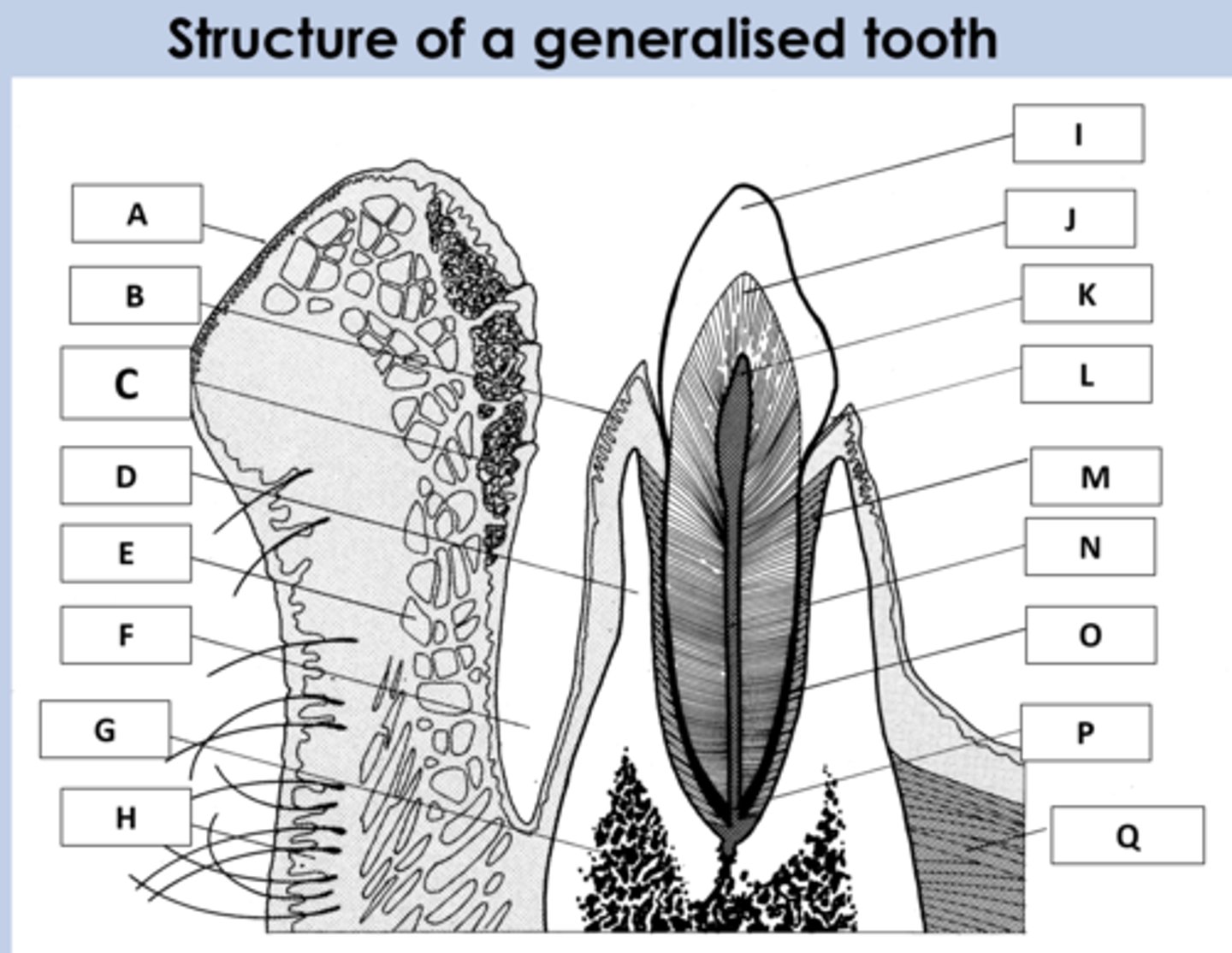
B = Gum
C = Cementum
D = Dentine
E = Enamel
P = Pulp
Label this longitudinal section of a simple tooth
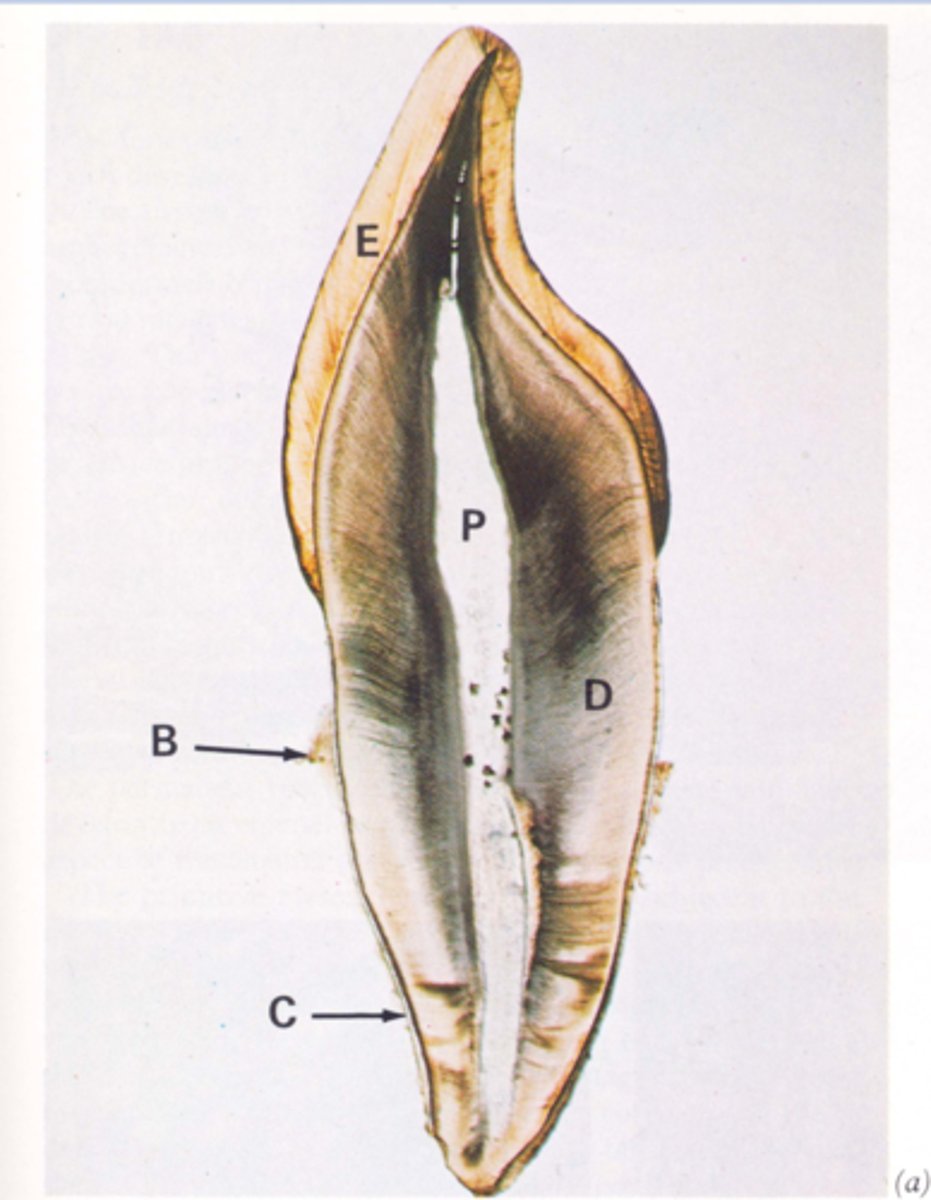
-Hard outer part projecting above the gums
-Ectodermal origin
-Formed by ameloblasts
-Acellular and cant regenerate
Describe enamel
-Mesodermal in origin
-Formed by odontoblasts
-Forms the bulk of the tooth
Describe dentine
-Odontoblasts recede from the newly formed dentine and remain as a continuous later on the surface of the pulp cavity
-This is secondary dentine
What occurs to dentine over time?
It gradually reduces its size.
What does the formation of secondary dentine do to the pulp cavity?
At sites of injury.
Where does tertiary dentine form?
-Mesodermal in origin
-Formed from calcified connective tissue
-Forms the outer lining of the tooth in the socket in brachydont teeth and completely covers the tooth in hypsodont teeth
-It is continuously but slowly produced throughout life so is thicker in older animals
Describe cementum
Cementum.
Which calcified tissue of the tooth is the least hard?
-It reflects the external shape of the tooth
-It is open at the apical foramen
-It is the central part of the tooth containing nerve fibres, lymphatic and blood vessels
-Smaller in older animals as secondary animals fills in the pulp cavity
Describe the pulp cavity
-Left
-The pulp cavities of the tooth are radiotranslucent suggesting that there is not much ossified tissue here meaning that there has not been much secondary dentine produced so far thus indicated the animal is young
Which image represents the dentition of a young animal? How do you know?

A functioning unit consisting of:
-Gingiva
-Periodontal ligament
-Cementum
-Alveolar bone
Its role s to anchor the tooth into the skill and provide a suspensory apparatus to absorb stresses induced at biting
What is the periodontium?
-The oral mucosa that covers the alveolar processes of the jaws and covers the neck of the teeth
-It is composed of keratinised stratified squamous epithelium
What is gingiva?
A = Gingival sulcus
B = Free gingiva
C = Attached gingiva
D = Free movable mucosa
E = Periodontal ligament
F = Cemento-enamel junction
Label this diagram of the tooth
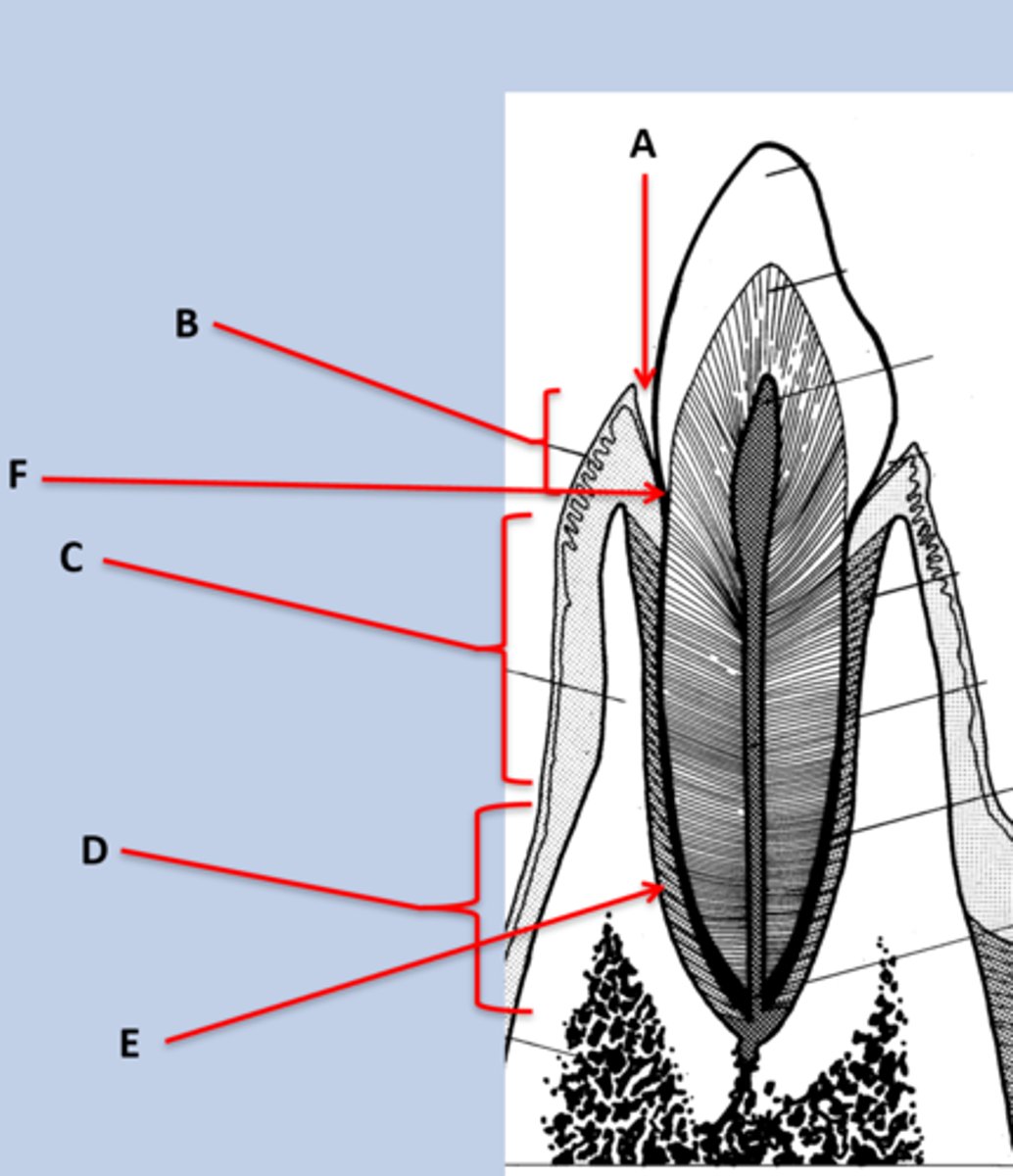
Coronal to the cemento-enamel junction.
Describe the anatomical positioning of the free gingiva
Gingiva tightly attached to the periosteum of the alveolus.
Describe the anatomical positioning of the attached gingiva
Gingival sulcus.
Which anatomical region of the tooth do veterinarians probe to assess periodontium health?
Periodontium disease, as it is failing due to the increased depth of the sulcus.
What is a deep gingival sulcus indicative of?
-Made of collagen fibres
-Attaches firmly to the cement of the tooth and the alveolus
-Its fibres are arranged in a sling formation allowing small movements of the teeth during mastication and acting as shock absorbers
Describe the periodontal ligament
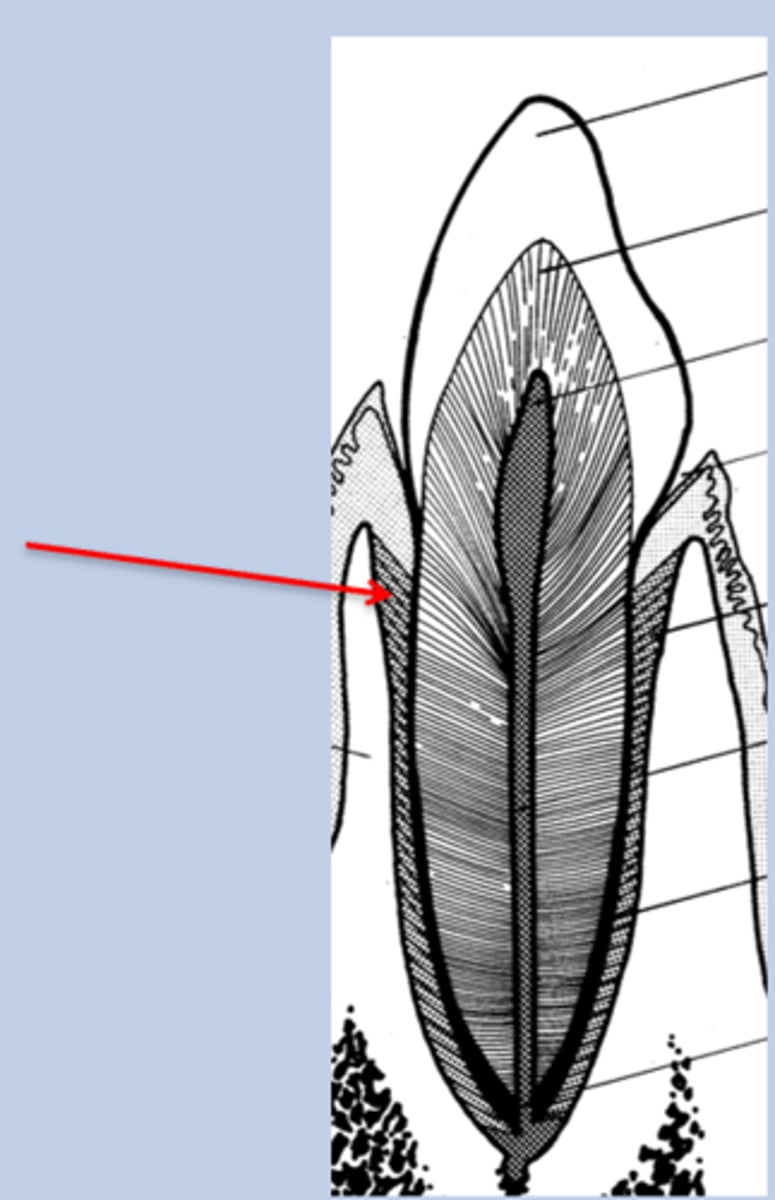
-Similar to other bone but it is the layer of bone lining the socket (the layer next to the periodontal ligament)
-Radiographically visible as thin white line
-Called the lamina dura
Describe alveolar bone
Dark line (X) = Periodontal space
White line (Y) = Lamina dura
Label this radiograph
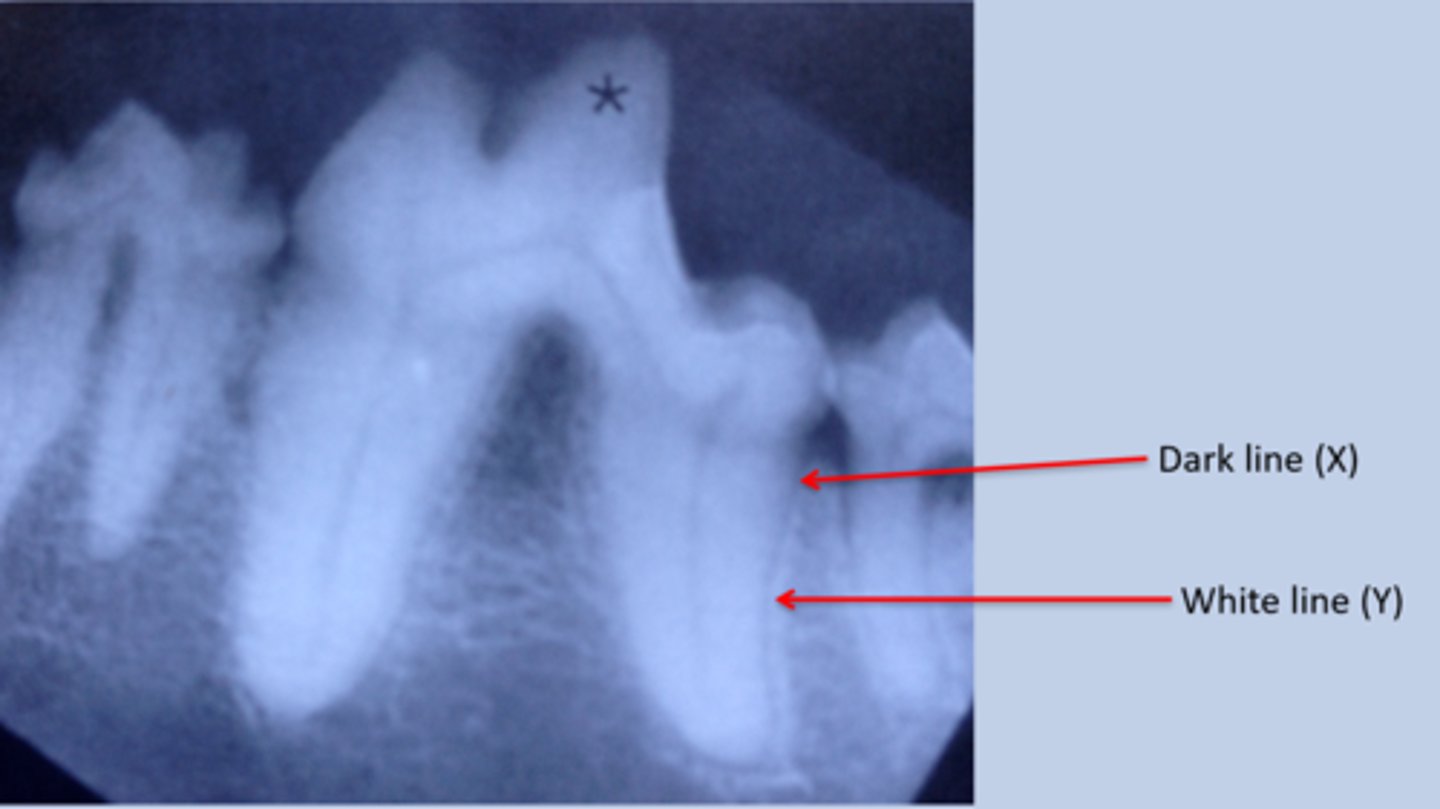
Trigeminal nerve (CN V).
What nerve are all teeth innervated by?
Maxillary alveolar nerve.
What are the upper teeth innervated by?
Mandibular alveolar nerve.
What are the lower teeth innervated by?
Diphydont.
What do you call an animal that has deciduous and permanent teeth in their lifetime?
Heterodont.
What is the name of dentition where there are different types of specialised teeth?
-Number the teeth on one side of the mouth then x 2
-Expressed as a fraction with the maxillary dentition at the top and the mandibular dentition at the bottom
Describe how you create dental formulae
44 total.
What is the normal number of teeth in a standard mammal?
-Those of horses
-High or long crowned with unerupted crown lying beneath the gum in all but very aged animals
-The root of the tooth is generally shorter than the corwn
Describe hypsodont teeth
-Those of a dog, cat and human
-Low crowned where all of the crown has erupted by adulthood
-The root is generally longer than the crown
Describe brachydont teeth
-Those of Rodentia
-Teeth grow throughout life and never develop true roots
-Always hypsodont
-Must be constantly worn away to prevent health issues
Describe aradicular/elodont dentition
-Teeth with true anatomical root structures
-Do not continuously grow throughout life
-Can be hypsodont or brachydont
Describe radicular/anelodont dentition
The enamel-covered part of the tooth regardless of location.
What is the anatomical crown?
Labial.
What is the anatomical term for the surface next to the lips?
Buccal.
What is the anatomical term for the surface next to the cheek?
Lingual.
What is the anatomical term for the surface next to the tongue?
Mesial.
What is the anatomical term for the surface touching the tooth in front?
Distal.
What is the anatomical term for the surface touching the tooth behind?
Occlusal.
What is the anatomical term for the masticatory surface?
-Radicular/Anelodont brachydont
-Incisors for grooming and nibbling
-Canine teeth adapted to piercing flesh to kill and hold prey
-Premolars/molars adapted to cutting like scissors (called carnassials)
-Molars for cutting and crushing hard food (e.g. bone)
Describe carnivore dentition
Carnivore and omnivore dental formulae.
For reference dental formulae
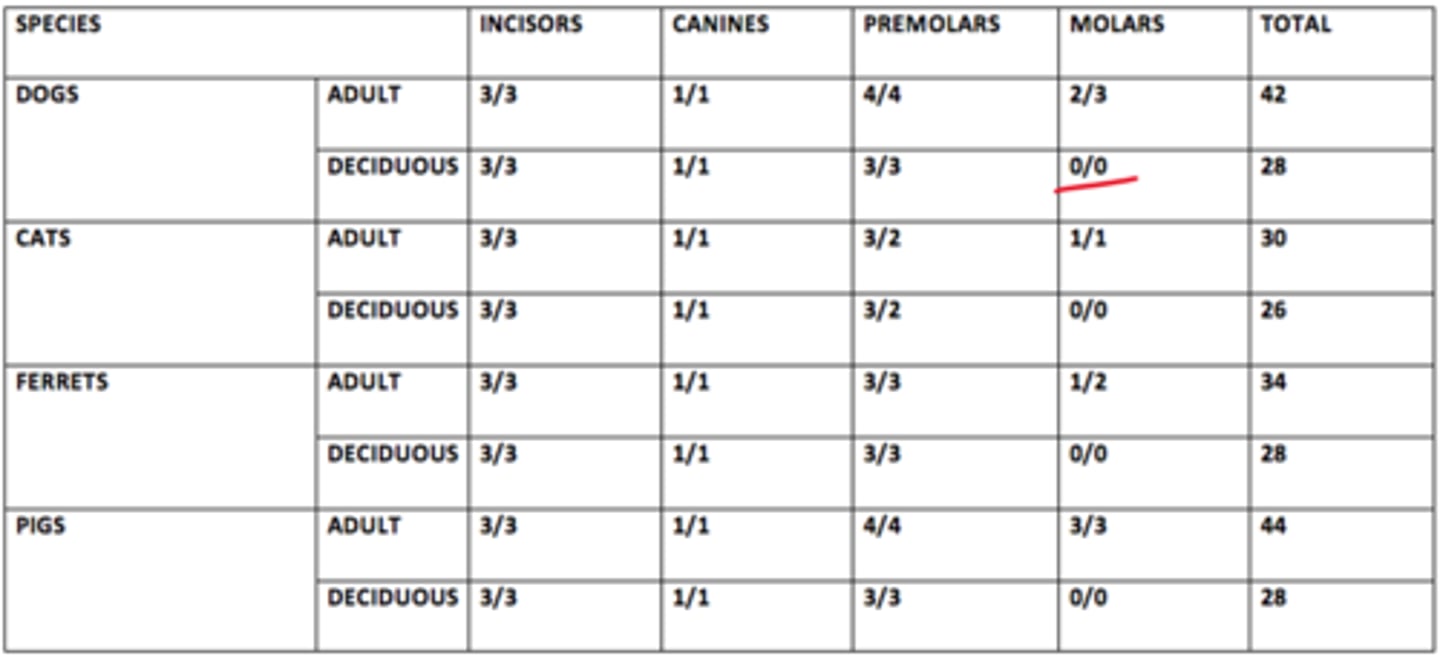
~6 weeks.
What is the approximate eruption time for all the deciduous teeth in the dog?
~6 weeks.
What is the approximate eruption time for all deciduous teeth in the cat?
7 months.
What is the approximate eruption time for all permanent teeth in the dog?
6 months.
What is the approximate eruption time for all permanent teeth in the cat?
UP4 and LM1.
Which teeth are the most powerful in the dog?
UP4 and LM1.
Which teeth are the carnassial teeth in the canine?
1 = UPM4
The upper carnassials
What is 1?
I = 3/3
C = 1/1
P = 4/4
M = 2/3
x2 = 42
What is the dental formula for a normal canine?
I = 3/3
C = 1/1
P = 3/2
M = 1/1
x2 = 30
What is the dental formula for a normal feline?
-Normal occlusion
-Normal oral pH in dogs and cats ~ 7.5
-Normal salivary levels
Describe what a healthy mouth should be like
-Maintains pH
-Contains enzymes, lysozymes and immunoglobulins that moderate bacterial colonisation
-Mechanically washes teeth
-Has antifungal and antiviral actions
How does saliva maintain a healthy mouth?
-Lower jaw is too long
-Common in brachycephalic breeds of dog
What is prognathism? What species is it common in?
-Lower jaw is too short
-Common in dolicocephalic breeds of dog
What is brachygnathism? What species is it common in?
Periodontal disease
What is the most common oral disease seen in small animals?
Stage 1 = Gingivitis - inflammation of the gingiva
Stage 2 = Early periodontitis - inflammation of the gingiva and periodontal ligament
Stage 3 = Advanced periodontal disease - Further breakdown of support tissues, higher tooth mobility, tooth loss. Usually in the upper arcade especially in the canine teeth. Can lead to oronasal fistulas (abnormal communication between the oral and nasal cavity
Describe the different stages of periodontal disease
Can lead to aspirational pneumonia due to food moving from the mouth into the nasal cavity then into the lungs.
Why are oronasal fistulas clinically important?
Biofilm on the teeth that is formed by bacteria colonising the dental pellicle (the protein film on the surface of teeth formed by saliva and food).
What is plaque?
-Plaque control
-Usually by mechanical prevention = chewing coarse textured food and tooth brushing
What is the best way of preventing periodontal disease?
Inorganic substances from saliva are deposited into bacterial plaque to form calculus. The surface of calculus is then readily colonised by further plaque.
How is calculus formed?
Tartar.
What is calculus colloquially known as?
-Bacterial colonisation and breakdown
-Abscesses and swelling
How does tooth decay (caries) occur? What may result because of tooth decay?
-Periodontal disease
-Tooth disease
Other than tooth decay, what else can cause abscesses?
-Lower incisors point forwards
-Canines (tusks) remain open-rooted in the male and grow throughout life
-Upper and lower canines rub against each other to maintain a sharpened edge
-In females, canine roots remain open for around 2 years, after they close and stop growing
-Little differential between premolars and molars but teeth get progressively larger towards the caudal end of the mouth
-Very tubercular occlusal surface for crushing food
Describe the dentition of pigs
8.
How many teeth are pigs born with?
18 months old.
When do pigs gain normal dentition?
No, mostly they will still have deciduous dentition at slaughter.
Do most commercial animals have adult teeth upon slaughter?